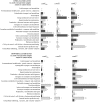Distinct roles of ComK1 and ComK2 in gene regulation in Bacillus cereus
- PMID: 21747963
- PMCID: PMC3128618
- DOI: 10.1371/journal.pone.0021859
Distinct roles of ComK1 and ComK2 in gene regulation in Bacillus cereus
Abstract
The B. subtilis transcriptional factor ComK regulates a set of genes coding for DNA uptake from the environment and for its integration into the genome. In previous work we showed that Bacillus cereus expressing the B. subtilis ComK protein is able to take up DNA and integrate it into its own genome. To extend our knowledge on the effect of B. subtilis ComK overexpression in B. cereus we first determined which genes are significantly altered. Transcriptome analysis showed that only part of the competence gene cluster is significantly upregulated. Two ComK homologues can be identified in B. cereus that differ in their respective homologies to other ComK proteins. ComK1 is most similar, while ComK2 lacks the C-terminal region previously shown to be important for transcription activation by B. subtilis ComK. comK1 and comK2 overexpression and deletion studies using transcriptomics techniques showed that ComK1 enhances and ComK2 decreases expression of the comG operon, when B. subtilis ComK was overexpressed simultaneously.
Conflict of interest statement
Figures




Similar articles
-
The competence transcription factor of Bacillus subtilis recognizes short A/T-rich sequences arranged in a unique, flexible pattern along the DNA helix.Genes Dev. 1998 May 15;12(10):1539-50. doi: 10.1101/gad.12.10.1539. Genes Dev. 1998. PMID: 9585513 Free PMC article.
-
Microarray analysis of the Bacillus subtilis K-state: genome-wide expression changes dependent on ComK.Mol Microbiol. 2002 Mar;43(5):1331-45. doi: 10.1046/j.1365-2958.2002.02833.x. Mol Microbiol. 2002. PMID: 11918817
-
Induction of natural competence in Bacillus cereus ATCC14579.Microb Biotechnol. 2008 May;1(3):226-35. doi: 10.1111/j.1751-7915.2008.00023.x. Microb Biotechnol. 2008. PMID: 21261842 Free PMC article.
-
Genetic networks controlling the initiation of sporulation and the development of genetic competence in Bacillus subtilis.Annu Rev Genet. 1995;29:477-508. doi: 10.1146/annurev.ge.29.120195.002401. Annu Rev Genet. 1995. PMID: 8825484 Review.
-
Ubiquitous late competence genes in Bacillus species indicate the presence of functional DNA uptake machineries.Environ Microbiol. 2009 Aug;11(8):1911-22. doi: 10.1111/j.1462-2920.2009.01937.x. Epub 2009 May 14. Environ Microbiol. 2009. PMID: 19453701 Review.
Cited by
-
Genomic versus Plasmid-Borne Expression of Germinant Receptor Proteins in Bacillus cereus Strain 14579.Microorganisms. 2022 Sep 2;10(9):1774. doi: 10.3390/microorganisms10091774. Microorganisms. 2022. PMID: 36144376 Free PMC article.
-
Expression of a cryptic secondary sigma factor gene unveils natural competence for DNA transformation in Staphylococcus aureus.PLoS Pathog. 2012;8(11):e1003003. doi: 10.1371/journal.ppat.1003003. Epub 2012 Nov 1. PLoS Pathog. 2012. PMID: 23133387 Free PMC article.
-
Spatio-temporal remodeling of functional membrane microdomains organizes the signaling networks of a bacterium.PLoS Genet. 2015 Apr 24;11(4):e1005140. doi: 10.1371/journal.pgen.1005140. eCollection 2015 Apr. PLoS Genet. 2015. PMID: 25909364 Free PMC article.
References
-
- Granum PE, Lund T. Bacillus cereus and its food poisoning toxins. FEMS Microbiol Lett. 1997;157:223–228. - PubMed
-
- Ehling-Schulz M, Fricker M, Scherer S. Bacillus cereus, the causative agent of an emetic type of food-borne illness. Mol Nutr Food Res. 2004;48:479–487. - PubMed
-
- Kovacs AT, Smits WK, Mironczuk AM, Kuipers OP. Ubiquitous late competence genes in Bacillus species indicate the presence of functional DNA uptake machineries. Environ Microbiol. 2009;11:1911–1922. - PubMed
Publication types
MeSH terms
Substances
LinkOut - more resources
Full Text Sources
Molecular Biology Databases

